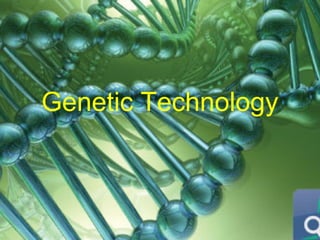
Genetic technology
- 2. Genetic Engineering • Making changes to DNA • Like changing the code of a computer program • Scientist use their knowledge of structure and chemical properties to make changes
- 3. Terms used to show it’s not the organism's natural reproductive process: • Genetic engineering • Recombinant DNA technology • Genetically Modified(GM) • Gene Splicing • Transgenic Organisms
- 4. Manipulating DNA 1. DNA Extraction – chemical procedure ruptures cell & separates the DNA from cell parts (Strawberry Lab) 2. Cutting DNA – restriction enzymes cut the DNA into smaller pieces called fragments (This 1 only between AAG)
- 5. 3. Separating DNA – a gel electrophoresis chamber separates DNA fragments to be analyzed 4. Make unlimited copies of DNA (PCR) 5. Study, Compare, & Analyze Results
- 6. Gel Electrophoresis • An Electric Voltage is applied to the gel to separate DNA fragments • The fragments move to the (+) positive side of the gel because DNA is (-) negatively charged & attracted • Bands are made of different sized DNA fragments • Smaller fragments move faster through the gel
- 7. G.E. can be used to: • Identify a DNA Fingerprint • Solve forensic cases • Determine Paternity • Examine specific proteins • Locate and identify particular genes (to tell if you are more likely to get Breast Cancer or Alzheimer's Disease) • Allows researchers to identify similarities and differences in the genomes of different organisms.
- 8. • Your Genome is your particular set of chromosomes (Your unique DNA) • DNA Fingerprint – uniqueness of an individual’s DNA .01% Difference (Fingerprint) 99.99% Same DNA as everyone else
- 9. Gel Electrophoresis Questions 1. What are the bands made of? DNA Fragments 1. Which bands move faster? Why? Shorter bands b/c they are smaller 1. What is the purpose of the restriction enzyme? To cut DNA into fragments
- 10. Gel Electrophoresis Questions 4. Why are the bands moving towards the positive side? B/c they are negatively charged and attracted to the positive 4. Are the samples identical? How do you know? No, the bands of all 3 samples don’t line up (same pattern) 4. Why is the electrical voltage applied? To supply the -/+ current for attraction/movement
- 11. Gel Electrophoresis DNA plus restriction enzyme Mixture of DNA fragments Gel Power source Longer fragments Shorter fragments
- 12. Results
- 15. Selective Breeding • Only allowing desired organisms to mate • Breeders increase the genetic variation in the population by causing mutations.
- 16. • Nearly all domestic animals and most crop plants have been produced by this breeding. Ex: Dogs, Horses, Fruit, etc.
- 17. • Hybridization causes hardier animals than the parents with desired traits Ex: Mule • Inbreeding helps ensure that breeds will continue to have unique characteristics Ex:Dogs
- 18. • Serious genetic problems can result from excessive inbreeding Ex: mad dog disease https://www.youtube.com/watch?v=aCv10_WvGxo
- 19. Cloning • A genetically identical organism produced from a single somatic cell. • In 1997, Ian Wilmut cloned a sheep called Dolly. Dolly and Bonnie
- 20. Pros vs. Cons of Cloning • Could Help Endangered Species Repopulate • Superhuman Race • No need for males • Medical Advancements • Plenty of Food • Moral Problems • Genetic Disorders • Health Problems • No Variety • Body Part Harvesting • Superhuman Race • No Males What do you think?
- 21. Cloning Questions 1. Which Sheep provides the egg cell? The black faced/legged Sheep B 2. Which Sheep provides the nucleus (DNA)? The white faced/legged Sheep A 3. Why is the nucleus removed from the egg? We only want DNA from Sheep A and there would be to much if not removed.
- 22. Cloning Questions 4. Which animal is the clone? The little lamb 5. Which 2 animals are genetically identical? The white faced/legged Sheep A and the little lamb ***Notice that Sheep B and C (Foster Mom) Look the same but they are not GENETICALLY 6. Why is an electrical voltage applied? To jump start the cell cycle for growth
- 23. Cloning Donor Nucleus Fused cell Embryo Egg Cell Sheep C – Foster Mom Cloned Lamb Sheep A Sheep B A donor cell is taken from the sheep’s udder The two cells are fused using electricity Egg cell is taken from other female The nucleus is removed The fused cell begins dividing normally Embryo is placed in the uterus of a foster mother The embryo develops normally into a lamb
Notas del editor
- Gel electrophoresis is used to separate DNA fragments. First, restriction enzymes cut DNA into fragments. The DNA fragments are then poured into wells on a gel, which is similar to a thick piece of gelatin. An electric voltage moves the DNA fragments across the gel. Because longer fragments of DNA move through the gel more slowly, they do not migrate as far across the gel as shorter fragments of DNA. Based on size, the DNA fragments make a pattern of bands on the gel. These bands can then be compared with other samples of DNA.
- The adult sheep is Dolly, the first mammal cloned from an adult cell. The lamb is Dolly’s first offspring, called Bonnie. The fact that Dolly was cloned did not affect her ability to produce a live offspring. Photo Credit: PA News
- In early 1997, Dolly made headlines as the first clone of an adult mammal.